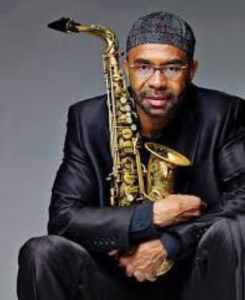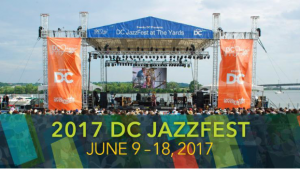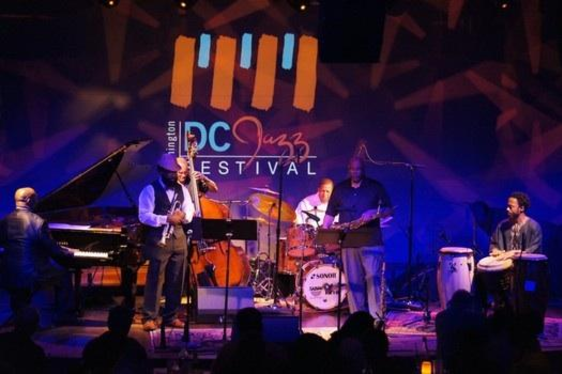 The Annual DC Jazz Festival will be held June 9-18, 2017 with 125 performances in over 40 venues throughout the city. CMP had the opportunity to interview Executive Director, Sunny Sumter, who has been with the Festival since 2008. She talks about this year’s lineup, sponsorship strategies, volunteer management, her main achievements, and the festival’s three-year plan.
The Annual DC Jazz Festival will be held June 9-18, 2017 with 125 performances in over 40 venues throughout the city. CMP had the opportunity to interview Executive Director, Sunny Sumter, who has been with the Festival since 2008. She talks about this year’s lineup, sponsorship strategies, volunteer management, her main achievements, and the festival’s three-year plan.
Q: This year’s lineup is very impressive: Robert Glasper, Kenny Garrett, Hiromi, Edmar Castañeda! How challenging was it to put together the lineup for this year?
 A: I think 2017 is our best year yet. We have an extraordinary artistic director, Willard Jenkins, who is an award-winning Jazz journalist and a curator that does work in New York, the Tri-C Jazz Festival in Ohio, and he has been doing this festival for a couple of years now. Between that and our partnerships, we have put together a lineup that is very diverse. That was the idea; we wanted to be able to celebrate the international language of Jazz and then we really wanted to celebrate the global aspect of what Jazz is. Robert Glasper is coming to the Yards, but we also have a wonderful London artist, they call him the human beat box. Jacob Collier is coming to the Yards as well. Pat Matheny is going to grace us with his amazing musicality at the Kennedy Center, which is the big showcase event that we do there. Edmar and Hiromi are unique; they just started a tour and I am excited to see them for the first time, as well.
A: I think 2017 is our best year yet. We have an extraordinary artistic director, Willard Jenkins, who is an award-winning Jazz journalist and a curator that does work in New York, the Tri-C Jazz Festival in Ohio, and he has been doing this festival for a couple of years now. Between that and our partnerships, we have put together a lineup that is very diverse. That was the idea; we wanted to be able to celebrate the international language of Jazz and then we really wanted to celebrate the global aspect of what Jazz is. Robert Glasper is coming to the Yards, but we also have a wonderful London artist, they call him the human beat box. Jacob Collier is coming to the Yards as well. Pat Matheny is going to grace us with his amazing musicality at the Kennedy Center, which is the big showcase event that we do there. Edmar and Hiromi are unique; they just started a tour and I am excited to see them for the first time, as well.
More than 125 performances in over 40 venues throughout DC in 2 weeks!
Q: Sunny, you have been part of this Festival since 2008. What makes this festival so unique and different from many other Jazz festivals around the country?
A: I had the great privilege of being involved with the festival since 2008. Our founder, Charles Fishman, was Dizzy Gillespie’s manager for many years. He actually started the festival in 2004 and what makes us unique is that we are really city wide. We are in 22 neighborhoods, over 40 venues; we call it a Jazz take over in DC. I think that’s what makes us unique. DC residents can experience their great city by going to [see] Jazz for 2 weeks in various neighborhoods throughout all four quadrants of the city. People that live in Maryland and Virginia can come and experience a part of DC they have never gone to. We have people that come from as far as Oakland, Richmond, Chicago, New York, and Philly; and they come because they want to experience DC and get their Jazz on at the same time. They want to go to the museums, because we have a lot of Jazz there. That’s what makes it really unique. There is no other partnership like it in the world. Plus, where can you go where you have embassies in one city? Most countries around the globe have an embassy here. We are fortunate enough to have partnerships with five embassies during the Jazz Festival: Italy, Korea, Japan, Spain and Canada, and they are all part of the Fishman Embassy Series concerts offered during the festival and throughout the year. So, it’s really quite unique in that way.
Q: Over the years, you went through a rebranding of the festival’s name, formerly known as the Duke Ellington Jazz Fest. I am sure you and your team have accomplished many things throughout these years. What are the achievements you feel most proud of?
 A: That’s such a good question, thank you for asking it. The festival was named in honor of our DC father of Jazz, Duke Ellington, and we felt very privileged that we had an opportunity to really speak about his contribution to the Jazz landscape every year. That was wonderful. But as we moved on, we realized we really are a DC Festival; we really are a celebrated entity here at the nation’s Capital. And we know that most major Jazz festivals are named after its city around the world, so we thought why not say DC Jazz Festival. At the time, there was a lot of rebranding going on with DC, so Washington,DC Convention & Tourism Corporation, which is the tourism arm of DC, changed its name to Destination DC. Then, the Washington Sports and Entertainment authority became Events DC; so, it became the right time for us to do it. We are really branding the city because it’s really a DC celebration of Jazz. Some of the rewards of that is that we’ve been able to partner with East of the River, which is more in the 7th & 8th [Wards]. We are also able to have a great partnership with the University of the District of Columbia that is going through a wonderful rebranding. And we are doing a couple of really exciting things with them, including our National Band Competition, that will be at the UDC and it will be a wonderful opportunity to really lift that university.
A: That’s such a good question, thank you for asking it. The festival was named in honor of our DC father of Jazz, Duke Ellington, and we felt very privileged that we had an opportunity to really speak about his contribution to the Jazz landscape every year. That was wonderful. But as we moved on, we realized we really are a DC Festival; we really are a celebrated entity here at the nation’s Capital. And we know that most major Jazz festivals are named after its city around the world, so we thought why not say DC Jazz Festival. At the time, there was a lot of rebranding going on with DC, so Washington,DC Convention & Tourism Corporation, which is the tourism arm of DC, changed its name to Destination DC. Then, the Washington Sports and Entertainment authority became Events DC; so, it became the right time for us to do it. We are really branding the city because it’s really a DC celebration of Jazz. Some of the rewards of that is that we’ve been able to partner with East of the River, which is more in the 7th & 8th [Wards]. We are also able to have a great partnership with the University of the District of Columbia that is going through a wonderful rebranding. And we are doing a couple of really exciting things with them, including our National Band Competition, that will be at the UDC and it will be a wonderful opportunity to really lift that university.
Q: Do you mind sharing with us some tips on how to approach new sponsors and partners?
A: We really provide an opportunity for young audiences to get to know Jazz; as Willard likes to say, to demystify Jazz. We like to have Jazz labs, because Jazz can sometimes be a little intimidating depending on the music, so it really is about understanding it. We love to have Meet the Artist, where people that are not familiar with certain artists, can have a conversation with them and it will help to grow their own appreciation for the music. I think most people walk away with the idea that it’s music overall. Maybe we shouldn’t define it as Jazz so much because it’s really just music; sometimes it’s Jazz hip hop, orchestral Jazz, or rock Jazz. I try to explain to our sponsors and partners that this is a community investment. That American musical heritage is Jazz. It was born right here, in the United States, in New Orleans, and it’s really America’s music. When you come to sponsors saying that, you have a platform to talk about and what their strategies are. So, it might be a new company coming into DC that wants to reach a certain demographic. Jazz is for everybody. Our demographic is exceptional: 42% of our demographic are between the ages of 18 and 40, that’s unheard of for Jazz in other parts of the country, and the reason why is because there is a lot of transient people. Millennials are coming to DC and they are getting their Jazz on. We are reaching that demo and we are also reaching children because we are giving them fun experiences with Jazz. We are doing a masterclass in Adams Morgan with Cyrus Chesnut and a few other exceptional players where they will teach middle school kids. They’re going to teach them to find their own voice through their instrument. That’s how we really do it. And we are really fortunate that our stakeholders, our Sponsors, they get it. We have a great partnership with Coca-Cola. They come on board and do a really great VIP party at the Yards, and they make sure that their brand is everywhere. The Washington Post is the official media sponsor of the festival and we are extremely happy to count on their support. DC Commission on the Arts and Humanities gives an extraordinary amount of money to arts organizations, like the DC Jazz Festival, to make sure we are shining the spotlight on DC artists throughout the festival. The National Endowment for the Arts gives us money to support the festival every year. We have great partnership with IT companies who want to make sure that people are using their products and services. I think we just really speak to people where they are and there is something for everybody. I always say that.
Jazz is so unique that there is something for everyone.
Q: How do you keep sponsors engaged and interested in supporting your event year after year?
A: It’s really about their return on investment. We try and start with a multi-year partnership so that we can grow together because often times when someone comes on for one year you are getting to know one another, it’s like dating. So, you are getting to know one another, you are figuring out how to dance together and then once you do, then we can choreograph some moves. And then before you know it, by year three you are in sync. I really believe that we have maintained the level of partners and sponsorships over the years because we look at each partnership individually and carefully. We assess it year after year, we give them a snapshot of the festival every year. Then we sit down after the festival to talk about what worked, what didn’t, and we come together with an even better partnership for the next year. That’s also true with our venue partners, and some partnerships are in-kind. The festival is really fortunate in that we are able to get a substantial amount of dollars through in-kind. We have a wonderful partnership with Sage Communications. They have been on board for at least 10 years, and they do our wonderful marketing and design. We have attorneys that we have multi-year partnerships with and they do all our legal services pro-bono; Forest City Enterprises, the Capital Riverfront Business Improvement District, are very generous on how they support the festival and the arts overall. So, I really think that it’s through multiple, multi-year partnerships that we are able to really thrive.
Q: Most festivals have a core team of volunteers. However I understand that organizing the volunteers can be a lot of work. Have you developed a system to manage all the volunteers so that they work well together and want to come back year after year?
A: We’ve had a volunteer program for about 10 years and it now runs well, but we had to learn to get to where we are today. We have a volunteer coordinator who is stellar, poised, very organized because you need that skill-set to never let them see you sweat. We have an orientation, where we bring them all together to talk about the festival, talk about what our policies and rules are, and they sign up right there, which I think is a good thing. They get to know us, we get to know them, and then they go off and do a really fine job. We have returning volunteers that come back every year. I personally like to go up to volunteers, ask them how they are doing, ask their names, ask them why they decided to volunteer, and always to thank them. We have over a hundred volunteers. Volunteer@dcjazzfest.org is the email for anyone that wants to volunteer.
Q: What is your three-year vision for the Festival?
A: We are very fortunate as a 501c3 non-profit service organization to have  the best Board of Directors on the planet! They are so incredibly caring, smart, strategic in their thinking, funny, and love arts and culture. We passed a three-year strategic plan which has some amazing goals that our team, which includes our staff, board, and stakeholders are actively pursuing right now. We really want to have sustainability alongside artistic excellence. Our product is excellent and we know that we really need to sustain this over time. We really want to find economic sustainable practices. We want multi-year stakeholders and we want the DC agencies to wrap their arms around us even more. We want to be performing at the airport and on the streets. We want everybody to know that there is a presence in DC in the second week of June.
the best Board of Directors on the planet! They are so incredibly caring, smart, strategic in their thinking, funny, and love arts and culture. We passed a three-year strategic plan which has some amazing goals that our team, which includes our staff, board, and stakeholders are actively pursuing right now. We really want to have sustainability alongside artistic excellence. Our product is excellent and we know that we really need to sustain this over time. We really want to find economic sustainable practices. We want multi-year stakeholders and we want the DC agencies to wrap their arms around us even more. We want to be performing at the airport and on the streets. We want everybody to know that there is a presence in DC in the second week of June.
For those two weeks, we want everybody to see there is a Jazz Celebration.
How do you do that? You put flags up on the street, you have big ads, you have musicians at the train stations, at the subway stations, at the airport, at the Amtrak; I think that’s when we know that we are a truly a city-wide celebrated festival of this great music. And the other thing is that we really want to be the very best Jazz presenter on the East Coast. We’ve got some great competition; my dearest friends, Jazz at Lincoln Center, Newport, and even here locally, you know, with the great work that the Smithsonian does, that the Kennedy Center does, amazing Jazz programs, and I could go on and on. But I really think that we are poised because of our particular, unique, diverse product, to be the best Jazz presenter on the East Coast.
For a detailed schedule of concerts please visit: http://www.dcjazzfest.org/schedule. You can purchase tickets for the June 17 & 18 concerts on the Yards here: http://www.ticketmaster.com/DC-Jazz-Fest-tickets/artist/1978345.
